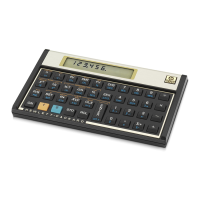118 Section 11: Multiple Programs
Example 1: Assuming that program memory still contains the last program from
the preceding section (which consisted of 17 program lines), store after that
program the office-supplies program from Section 8 (page 86). Since this is the
second program to be stored in program memory, we’ll ensure that a i000
instruction separates it from the first program by doing step 3 in the procedure
above. Furthermore, since this program does not end with a loop, we’ll do steps
5 and 6 too.
Example 2: With the two programs now stored in program memory from the
preceding examples (occupying 27 program lines), store the amortization
program from Section 9 (page 102). Since there are already two programs stored
in program memory, we’ll skip step 3 in the procedure above. Furthermore, since
the amortization program ends with a loop, we’ll skip steps 5 and 6. When the
amortization program was stored at the beginning of program memory, the i
instruction at the end of the program branched to the :0 instruction in line
002. Since the :0 instruction is now in line 029, we’ll specify that line
number with the i instruction in line 034.
Keystrokes
(RPN mode)
Display
fs
000,
Sets calculator to Program mode.
gi.017
017,43,33,002
Sets calculator to last line keyed
into program memory.
gi000
018,43,33,000
Ensures that second program is
separated from first by i000.
\
019, 36
Keys in program.
2
020, 2
5
021, 5
b
022, 25
-
023, 30
5
024, 5
+
025, 40
t
026, 31
Halts program execution.
gi019
027,43,33,019
Branches to beginning of program.
fs
12,000.00
Sets calculator back to Run mode.
(Display shown assumes results
remain from running program in
previous example.)

